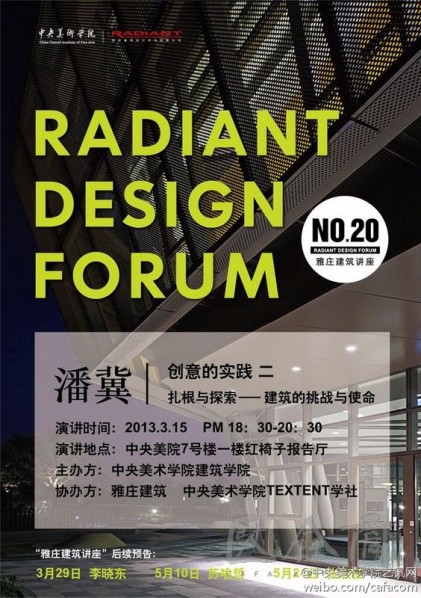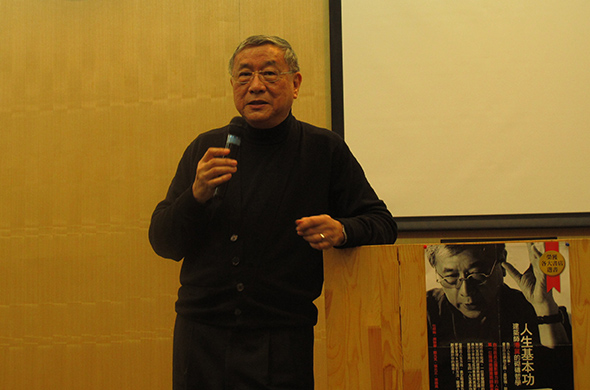The Radiant Design Forum series “Idea’s Practice No.2: Rooted and Exploration – the Challenge and Mission of Architecture”, a lecture by Taiwan architect Joshua Jih Pan, was held at the Red Chair Lecture Hall of Building 7, CAFA, at 6:30 am, on Friday, March 15, 2013. Organized by the School of Architecture, CAFA, and in cooperation with Radiant Architecture and TEXTENT, the lecture was presided over by Lv Pinchang, President of the School of Architecture, CAFA.
Born in Tianjin, in 1963, Mr. Pan graduated from the Department of Architecture, Taiwan National Cheng Kung University, and was destined for the USA to study, he completed the professional degree programs in the Department of Architecture, Rice University, and obtained a master’s degree in architecture and urban design from Columbia University, New York, he is a registered architect in various areas including China. J.J. Pan and Partners was founded in January, 1981 by Mr. Joshua Jih Pan, FAIA.The firm and its subsidiary companies, now with over 200 staff members are committed to providing comprehensive diversity together with strict quality control throughout the process of professional service and they have accomplished more than 500 architectural works, and continuously wins international and domestic architectural design awards and publications within professional magazines. Different from other architects, Joshua Jih Pan is not often in the public focus, and his works are like silent artworks, rich accomplishments and excellent performance, moving humans’ hearts after the disappearance of the hustle and bustle, transforming the instant to the eternal.
Ahead of the very beginning, Pan said he was not going to focus on showing his architectural works, but to communicate some architectural ideas and exchange experiences with the audience, in the hope that the students present can be architects with influence and contribution to society and the environment. First of all, he showed a photo of the film “Life of Pi” by PPT, a demonstration of a ship driven forward in the wind and on waves, expressing that most of the time, life is about floating, an adventure, and we must accept the challenges, and he talks about the difficulties he encountered in the early years of study in the US, he tells the audience that we should start a thing from an in-depth observation and the fundamental. The lecture was divided into four sections, elaborated with its targeted architectural works.

Starting from the fundamental
In this section, Pan mentioned four key words, firstly the architectural principle: there is not only the literature to embody the way, but also the architecture to “embody the way”; secondly, the architectural concept: respect for nature and the environment, using professional technology according to the correct principles, caring for the users, a free and impartial design of architecture; thirdly, the architectural task: professional service with sincerity, reliable execution with precision, and timeless design with grace; fourthly architectural vision: that is the harmonious combination of “climate, people, object, and self”. Pan said, no matter how good the design is, it is actually a natural destroyer, but in order to try to achieve a better effect, it is necessary to use proper technology and science, to achieve the best balance.
Exploration of the issue
In this section, Pan talked about a lot of real cases. Firstly about the “climate”, that requires environmental care: Fleur De Chine Hotel at Sun Moon Lake, Taipei, the fusion of the hotel and nature, the greatest degree of mastery and combination of landscapes; Chapel of the Suan-Lien Social Welfare Park, a nursing facility for the elderly, the church is like a tent design of three curves, allowing old people to find warmth and comfort from each other. The works mentioned above were different types of architecture. In addition, there was the TSMC Plant 12 and the headquarters building, in the process of constant consultation and discussion with the owners, the project was finally designed by a scattered architectural group, of excellent environmental fusion. In addition, Pan had talked about selected plant designs, among these works, some won architectural design awards.
Secondly, it was about “people”: space and activities: Taipei Truth Lutheran Church in Taiwan, there was more spare ground for a public space, whose existence was to benefit the surrounding environment, and this work won the Citation Award, 2006 AIA New York State Inc., mainly because of its interpretation of how a limited building improved the environment, which he believed, was an important issue for an architect. Then he talked about the Scooter Garage of Jiaotong University, winning the WACA Gold Medal Award, as well as Hunya Chocolate Museum with a visual appearance of a staggered virtual and reality.
Thirdly it was “object”, that used modern technology: For this, the cases cited by Pan were the stadium of a cultural university in Taiwan, headquarters of science and technology R & D and production, dealing with new solar energy, performing interesting folded surfaces to express fluctuations and conversions, as well as the National Library of Public Information, “Knowledge Flow” in correspondence with the vertical development of the surrounding urban architecture.
Finally, it was “self”, using culture and history: Located in the old industrial park in Shanghai, Horizon Design Office was a cultural ruin of historical value, Pan said, for the heritage of the memorial space, and the formation of the spatial and historical dialogue, the old materials were of a new application, making a comfortable fusion of the old and new materials, and it won a number of awards. In addition, his design of the Chinese Culture University Da-Sha House won the Annual Design Awards AIA New York Chapter.
The challenges of practice
In addition to the real cases, Pan thought that an architect would encounter a lot of practical problems. For example, how to run a team of about 300 people, by organizing some activities such as discussions and training, the consensus, common values and sense of mission were established; at the same time, sharing the achievements, creating a good environment, architects were sharing and learning with each other, and making common progress. Through their joint efforts, about forty to fifty pieces of the firm won domestic and international awards.
Professional mission
Pan believed that a lot of missions were in need of collective achievement. Only a rich accumulation of resources with inherited experiences showing progress by society is possible.
There are four key principles: firstly, dedicated to making progress professionally, it was easier to talk about adhering to our principles when you were excellent; Secondly without hesitation, nor impatient panic, keeping a distance from the crowd; Thirdly, being humble, knowing what is sufficient and avoiding getting carried away; Fourthly, of a servant’s aspiration, to be an escrow rather than owner. In addition, we should also be able to offer homeopathy for the “favorable climate and geographical position and support to the people”, as emphasized by Chinese people.
Pan said the most important thing to him was that these experiences and achievement would be helpful to the surrounding environment and people, and for the architectural design, he was always mentally in pursuit of a natural expression of rich accomplishment and excellent performance, a reasonable manner, respecting nature and loving people.
Finally the audience asked him some questions on the architectural design, such as whether the emphasis is on appearance or internal space, as well as the problems of plagiarism and Shanzhai (Imitating the appearance or function of the mainstream brand products at a very low cost, and ultimately beyond the brand in terms of appearance, function, and price) in architecture, Pan patiently and meticulously gave his answers.
Text and photo by Zhou Mengyue, translated by Chen Peihua/CAFA ART INFO





























